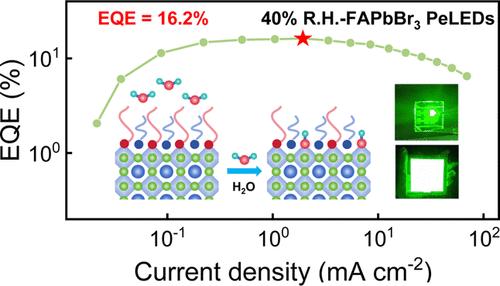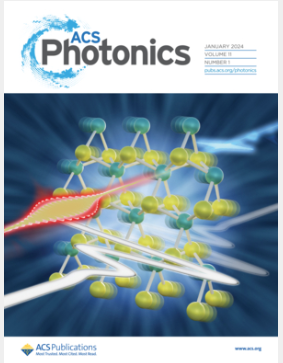Unveiling the Effect of Synthetic Atmospheric Humidity on the Performance of FAPbBr3 Nanocrystals and Their PeLEDs
IF 6.7
1区 物理与天体物理
Q1 MATERIALS SCIENCE, MULTIDISCIPLINARY
引用次数: 0
Abstract
The polar solvent of water can disrupt the structure of lead halide perovskite nanocrystals (PeNCs), and its presence is inevitable during the synthesis process. Therefore, it is crucial to understand the impact of synthetic atmospheric humidity on the performance of PeNCs and their electroluminescence. In this study, we first synthesized formamidine lead bromide (FAPbBr3) PeNCs at different relative air humidities and explored their optoelectronic properties and electroluminescence. We found that under optimal humidity conditions (40% R.H.), water molecules can reduce the nucleation growth barrier of PeNCs through ligand replacement. This process results in nanocrystals with good crystallinity and fewer defects, thereby reducing defect states and nonradiative recombination. The perovskite light-emitting diodes (PeLEDs) based on these FAPbBr3 PeNCs exhibit a maximum luminance of 39,000 cd m–2 and a peak external quantum efficiency of 16.2%, surpassing most reported values in the literature without the use of any additional additives. This study elucidates the role of atmospheric humidity in the growth of PeNCs and introduces the concept of humidity-assisted synthesis, which is crucial for scaling up production in the industry.

揭示合成大气湿度对FAPbBr3纳米晶体及其ped性能的影响
水的极性溶剂会破坏卤化铅钙钛矿纳米晶体的结构,是合成过程中不可避免的存在。因此,了解合成大气湿度对聚苯乙烯及其电致发光性能的影响至关重要。本研究首次在不同相对空气湿度下合成了甲脒型溴化铅(FAPbBr3),并对其光电性能和电致发光性能进行了研究。我们发现,在最佳湿度条件下(40% R.H.),水分子可以通过配体置换降低pnas的成核生长屏障。该工艺得到的纳米晶体结晶度好,缺陷少,从而减少了缺陷状态和非辐射复合。基于这些FAPbBr3 pce的钙钛矿发光二极管(PeLEDs)的最大亮度为39,000 cd m-2,峰值外量子效率为16.2%,在不使用任何额外添加剂的情况下超过了文献中大多数报道的值。本研究阐明了大气湿度在pce生长中的作用,并介绍了湿度辅助合成的概念,这对于扩大工业生产至关重要。
本文章由计算机程序翻译,如有差异,请以英文原文为准。
求助全文
约1分钟内获得全文
求助全文
来源期刊

ACS Photonics
NANOSCIENCE & NANOTECHNOLOGY-MATERIALS SCIENCE, MULTIDISCIPLINARY
CiteScore
11.90
自引率
5.70%
发文量
438
审稿时长
2.3 months
期刊介绍:
Published as soon as accepted and summarized in monthly issues, ACS Photonics will publish Research Articles, Letters, Perspectives, and Reviews, to encompass the full scope of published research in this field.
文献相关原料
公司名称
产品信息
阿拉丁
Formamidine bromide (FABr)
阿拉丁
N,N-Dimethylformamide (DMF)
阿拉丁
PbBr2
阿拉丁
octylamine (OTAm)
阿拉丁
oleic acid (OA)
阿拉丁
chloroform
阿拉丁
acetonitrile
阿拉丁
poly(9-vinlycarbazole) (PVK)
阿拉丁
Octane (C8H18)
阿拉丁
1,3,5-Tris(1-phenyl-1H-benzimidazol-2-yl)benzene (TPBi)
阿拉丁
Formamidine bromide (FABr)
阿拉丁
N,N-Dimethylformamide (DMF)
阿拉丁
PbBr2
阿拉丁
Octylamine (OTAm)
阿拉丁
Oleic acid (OA)
阿拉丁
Chloroform
阿拉丁
Acetonitrile
阿拉丁
Poly(9-vinylcarbazole)
阿拉丁
Octane (C8H18)
阿拉丁
Poly(ethylene dioxythiophene):polystyrenesulfonate
阿拉丁
1,3,5-Tris(1-phenyl-1H-benzimidazol-2-yl)benzene (TPBi)
 求助内容:
求助内容: 应助结果提醒方式:
应助结果提醒方式:


